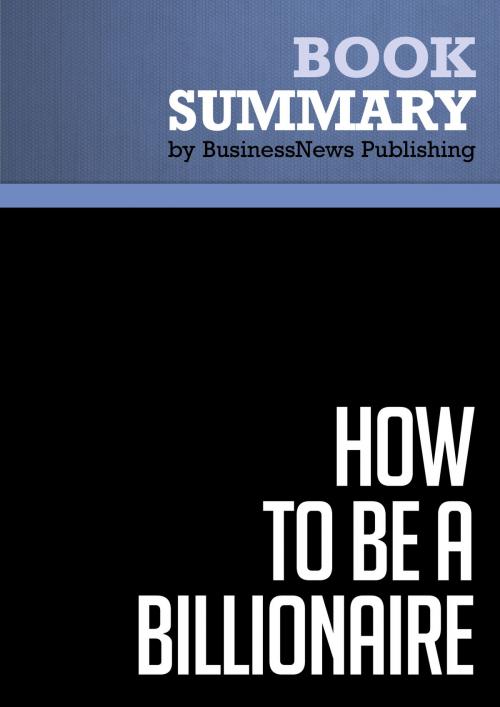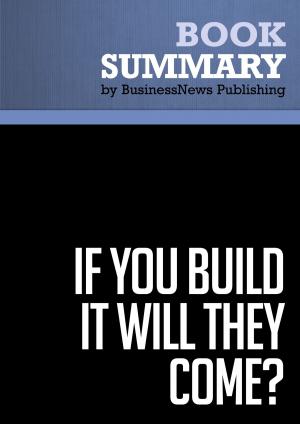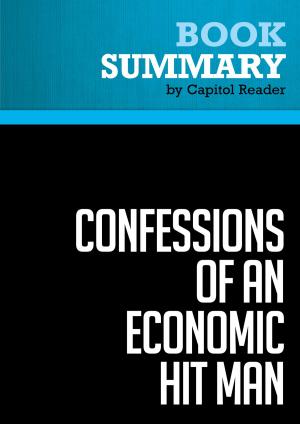Summary: How To Be A Billionaire - Martin Fridson
Business & Finance, Economics, Development & Growth, Management & Leadership, Management| Author: | BusinessNews Publishing | ISBN: | 9782806246783 |
| Publisher: | Must Read Summaries | Publication: | February 15, 2013 |
| Imprint: | Business Book Summaries | Language: | English |
| Author: | BusinessNews Publishing |
| ISBN: | 9782806246783 |
| Publisher: | Must Read Summaries |
| Publication: | February 15, 2013 |
| Imprint: | Business Book Summaries |
| Language: | English |
This work offers a summary of the book “HOW TO BE A BILLIONAIRE: Proven Strategies From The Titans Of Wealth” by Martin Fridson.
Billionaires make their money in different markets, but the methods and strategies are remarkably similar. Martin Fridson’s research has isolated these methods, and explains them in a clear way for the reader. He suggests that billionaire start with the same elements as other successful businesses, but to that they add unique touches. They focus efforts in high-growth industries, take bigger risks and apply unorthodox business strategies. Above all, they chose one or two goals, and everything else in their lives is subordinate to that.
Fridson uses examples to describe each strategy clearly. For example, one of the strategies, is extraordinary, monumental risk: not every billionaire takes risks all the time, but at a crucial points, they have done. WalMart’s founder, Sam Walton made every effort to avoid debt in general, but when bar-coding and satellite communications became available, he invested, before they were thought to be merchandising ideas. This risk paid vast dividends that pushed WalMart past its competitors.
He uses examples such as this for every strategy, demonstrating that billionaires do not have a “secret formula”: they used approaches that anyone can learn, and apply. How to be a Billionaire is a thought-provoking read.
Billionaires make their money in different markets, but the methods and strategies are remarkably similar. Martin Fridson’s research has isolated these methods, and explains them in a clear way for the reader. He suggests that billionaire start with the same elements as other successful businesses, but to that they add unique touches. They focus efforts in high-growth industries, take bigger risks and apply unorthodox business strategies. Above all, they chose one or two goals, and everything else in their lives is subordinate to that.
Fridson uses examples to describe each strategy clearly. For example, one of the strategies, is extraordinary, monumental risk: not every billionaire takes risks all the time, but at a crucial points, they have done. WalMart’s founder, Sam Walton made every effort to avoid debt in general, but when bar-coding and satellite communications became available, he invested, before they were thought to be merchandising ideas. This risk paid vast dividends that pushed WalMart past its competitors.
He uses examples such as this for every strategy, demonstrating that billionaires do not have a “secret formula”: they used approaches that anyone can learn, and apply. How to be a Billionaire is a thought-provoking read.
This work offers a summary of the book “HOW TO BE A BILLIONAIRE: Proven Strategies From The Titans Of Wealth” by Martin Fridson.
Billionaires make their money in different markets, but the methods and strategies are remarkably similar. Martin Fridson’s research has isolated these methods, and explains them in a clear way for the reader. He suggests that billionaire start with the same elements as other successful businesses, but to that they add unique touches. They focus efforts in high-growth industries, take bigger risks and apply unorthodox business strategies. Above all, they chose one or two goals, and everything else in their lives is subordinate to that.
Fridson uses examples to describe each strategy clearly. For example, one of the strategies, is extraordinary, monumental risk: not every billionaire takes risks all the time, but at a crucial points, they have done. WalMart’s founder, Sam Walton made every effort to avoid debt in general, but when bar-coding and satellite communications became available, he invested, before they were thought to be merchandising ideas. This risk paid vast dividends that pushed WalMart past its competitors.
He uses examples such as this for every strategy, demonstrating that billionaires do not have a “secret formula”: they used approaches that anyone can learn, and apply. How to be a Billionaire is a thought-provoking read.
Billionaires make their money in different markets, but the methods and strategies are remarkably similar. Martin Fridson’s research has isolated these methods, and explains them in a clear way for the reader. He suggests that billionaire start with the same elements as other successful businesses, but to that they add unique touches. They focus efforts in high-growth industries, take bigger risks and apply unorthodox business strategies. Above all, they chose one or two goals, and everything else in their lives is subordinate to that.
Fridson uses examples to describe each strategy clearly. For example, one of the strategies, is extraordinary, monumental risk: not every billionaire takes risks all the time, but at a crucial points, they have done. WalMart’s founder, Sam Walton made every effort to avoid debt in general, but when bar-coding and satellite communications became available, he invested, before they were thought to be merchandising ideas. This risk paid vast dividends that pushed WalMart past its competitors.
He uses examples such as this for every strategy, demonstrating that billionaires do not have a “secret formula”: they used approaches that anyone can learn, and apply. How to be a Billionaire is a thought-provoking read.















